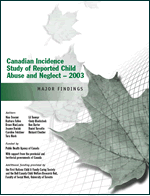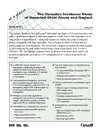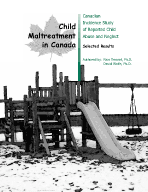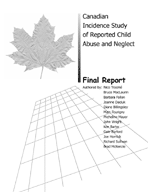Child abuse in Canada
Health Canada, Child Maltreatment Section states "Child maltreatment can be categorized into several broad types including physical abuse, sexual abuse, neglect/failure to provide, and emotional maltreatment.
Physical abuse (child abuse) is the deliberate application of force to any part of a child's body, which results or may result in a non-accidental injury. Physical abuse may include shaking, choking, biting, kicking, burning, poisoning, holding a child under water, or any other harmful or dangerous use of force or restraint. Most child physical abuse is associated with physical punishment or is confused with child discipline.
Sexual abuse (child abuse) occurs when an adult or youth uses a child for sexual purposes. Sexual abuse includes fondling, intercourse, incest, sodomy, exhibitionism, and commercial exploitation through prostitution or the production of pornographic materials.
Neglect/failure to provide (child abuse)occurs when a child's parents or caregivers do not provide the requisite attention to the child's emotional, psychological, or physical development.
Public Health Agency of Canada Releases Key Study on Reported Child Abuse And Neglect
Press Release, October 4, 2005
OTTAWA - The Public Health Agency of Canada today released the report of the second cycle of the Canadian Incidence Study of Reported Child Abuse and Neglect (CIS), a national child health surveillance activity that provides information in the area of child abuse and neglect. Read More ..
Public Health Agency of Canada (PHAC)
2001 - Murders of children
| Biological fathers | 16 |
| Biological mothers | 16 |
| Step-fathers | 4 |
| Step-mothers | 1 |
| Sibling | 3 |
| Spouse | 0 |
| Other family | 3 |
| Total non-family homicides | 26 |
| Acquaintance | 4 |
| Stranger | 11 |
| Unknown | 5 |
| Total solved homicides | 69 |
Fortunately, the number of children murdered in Canada is very low.
view / read the 2003 report in english pdf (360 kb) d??bute fran??ais pdf (460 kb)
view / read the 2004 report in english pdf (360 kb) d??bute fran??ais pdf
Criminal Code of Canada
PART VIII OFFENCES AGAINST THE PERSON AND REPUTATION
Murder, Manslaughter and Infanticide
Infanticide
233. A female person commits infanticide when by a willful act or omission she causes the death of her newly-born child, if at the time of the act or omission she is not fully recovered from the effects of giving birth to the child and by reason thereof or of the effect of lactation consequent on the birth of the child her mind is then disturbed. R.S., c. C-34, s. 216.
A mother who murdered her baby committed a lesser crime than if she had killed an adult .... It doesn't make sense.
The law has always treated the murder of an infant by the mother as a lesser crime than murder of an older child or adult. Sections 216 and 590 of the Criminal Code of Canada are a reflection of a reluctance to find the mother guilty of murder of her baby. Now, the Law Reform Commission of Canada and the Butler Committee has proposed abolishing sections 216 and 590. The author agrees that the abolishment of Canada's infanticide provisions is the logical change to the law.
Mentally ill murderers will always have the legal defence of "diminished capacity", whether they are male or female. Depression after giving birth is a medical condition which is one of the mental illnesses that cause "diminished capacity".
On October 4th, 2005, The Public Health Agency of Canada released the report of the second cycle of the Canadian Incidence Study of Reported Child Abuse and Neglect Major Findings2003 (CIS).
The study highlights a dramatic 125 percent increase in the incidence of substantiated child abuse and neglect cases in 2003, the most recent period measured.
Child Maltreatment in Canada - Overview Paper - 2006
by Susan Jack, RN, PhD, Catharine Munn, MD, FRCP(C), Chiachen Cheng, MD, MPH, FRCP(C), and Harriet MacMillan, MD, MSc, FRCP(C)
As an update of the Child Abuse and Neglect Overview Paper (1997), this paper highlights the epidemiology of child maltreatment, including incidence, prevalence and correlates, based predominantly on, but not limited to, Canadian research and data. Newly released data from studies such as the Canadian Incidence Study of Reported Child Abuse and Neglect-2003 are highlighted. The paper concludes with a list of references, resources and contact information for individuals requiring further information about child maltreatment. 2006, 13 p.
 Canadian Incidence Study of Reported Child Abuse and Neglect - Major
Findings - 2003
Canadian Incidence Study of Reported Child Abuse and Neglect - Major
Findings - 2003
??tude canadienne sur l'incidence des signalements de cas de violence et de n??gligence envers les enfants - 2003
Canadian Incidence Study of Reported Child Abuse and Neglect - 2003
The Canadian Incidence Study of Reported Child Abuse and Neglect (CIS) is the core national child maltreatment surveillance activity of the Public Health Agency of Canada. This is the report of the major findings of the second cycle of the CIS (CIS-2003). The primary objective is to provide reliable estimates of the scope and characteristics of reported child abuse and neglect. The CIS-2003 addresses the five principal forms of maltreatment: physical abuse, sexual abuse, neglect, emotional maltreatment and exposure to domestic violence. 2005, 160p.
Canadian Incidence Study of Reported Child Abuse and Neglect (CIS-1) (2001)
The Canadian Incidence Study of Reported Child Abuse and Neglect (CIS) ( 2001) is the first nation-wide study to examine the incidence of reported child maltreatment and the characteristics of children and families investigated by Canadian child welfare services. The CIS addresses the four principal forms of maltreatment: physical abuse, sexual abuse, neglect and emotional maltreatment.

At a Glance ....The Canadian Incidence Study of Reported Child Abuse and Neglect (CIS) 2001
The objective of this four page fact sheet, is to provide readers with a snapshot of the CIS. At a glance ... outlines the goals, methods and key results from the study. Definitions of the four categories of maltreatment and the respective subcategories are given. This document is intended for educators, media, parent groups, and other interested parties.

Canadian Incidence Study of Reported Child Abuse and Neglect 2001 - Selected Results.
CMIC is a companion to the CIS Final Report and presents substantiated rates of reported child maltreatment in Canada from the CIS data set. This report is intended for a wider audience than the CIS Final Report. Information in the document is enriched with graphs and tables

Canadian Incidence Study of Reported Child Abuse and Neglect (CIS): Final Full Report - 2001
This publication presents the major descriptive findings from the CIS. This report is directed to a professional audience. The goal of the document is to explain the methodology of the CIS and presents the study's findings in detail. Included in the CIS Final Report is an executive summary which provides a brief, accessible synopsis of the research results.
??tude canadienne sur l'incidence des signalements de cas de violence et de n??gligence envers les enfants - 2001
Canadian Statistics (1998)
An estimated 135,573 child maltreatment investigations were conducted in Canada in 1998. This figure corresponds to an estimated incidence rate of 21.52 investigations per 1,000 children. It is important to keep in mind, however, that this incidence rate includes all child maltreatment investigations, regardless of whether the report was substantiated or not.
Almost half (45%) of these reports were substantiated by the investigating worker. The remaining investigations either had insufficient information to substantiate, but the worker maintained suspicion that maltreatment had occurred (22%), or the worker determined on the basis of the investigation that the child had not been maltreated (33%). Of the estimated 21.52 investigations per 1,000 children in Canada in 1998, an estimated 9.71 per 1,000 were substantiated, 4.71 per 1,000 were suspected, and 7.09 per 1,000 were unsubstantiated.
Categories of Maltreatment
Child neglect was the most common reason for investigation (40% of all investigations), followed by physical abuse (31%), emotional maltreatment (19%), and sexual abuse (10%). The substantiation rate for emotional maltreatment as the primary reason for investigation was highest of all four categories of maltreatment (54% substantiated), whereas the other three categories had similar levels of substantiation (physical abuse: 34%, sexual abuse: 38%, neglect: 43%).

News Release - University of Pennsylvania
OCTOBER 17, 2005
Penn Study Finds Physically Abused Boys May Be more likely to Commit Domestic Violence As Adults
Most Abuse of Boys Done by Parents ... Most Frequently Mothers
(Philadelphia, PA) - According to a study in the October 18 issue of the Annals of Internal Medicine, a history of childhood physical abuse may be common in men from urban settings, and these men with physical abuse histories may be more likely to commit domestic violence. The study found that the childhood abuse was primarily committed by parents, with mothers being the most frequent abusers. Read More ..
Female Aggression
"Relational aggression is behavior specifically intended to hurt another child's friendships or feelings
of inclusion in a peer group."
- Nina S. Mounts, Ph.D.,
The Ohio State University
Human Development and Family Life Bulletin
A Review of Research and Practice
Volume 3, Issue 2, Summer 1997 Female Aggression
Read More ..
Female Sexual Predators
We have a complete webpage on this subject
Female Sexual Predators section on this website ... click here
Health Canada - The Invisible Boy: Revisioning the Victimization of Male Children and Teens.
![]()
Child sexual abuse by women
The sexual abuse by women of children and teenagers
BBC, UK TV Programme - Panorama - BBC1 - 10 pm Monday 6th October 1997
U.S. Statistics Child Abuse ( Child Maltreatment )
U.S. Dept. of Health and Human Services Study indicating that women are the main perpetrators of abuse of children 77% of the time that the child protection agencies investigate.
The DHHS 2003 Child Maltreatment Study
The DHHS 2002 Child Maltreatment Study
The DHHS 2001 Child Maltreatment Study
The DHHS 2000 Child Maltreatment Study
The DHHS 1999 Child Maltreatment Study
The DHHS 1998 Child Maltreatment Study HTML
The DHHS 1997 Child Maltreatment Study HTML
The DHHS 1996 Child Maltreatment Study HTML
The DHHS 1995 Child Maltreatment Study HTML
The US's NIS-3 study, expanded data sources to include untrained people (e.g. sheriff's offices), but still indicate the patterns of maltreatment for various types of parents.
This report states that natural parents account for some 78% of child maltreatment. It states that 46% of the time the natural father was involved and 75% of the time the natural mother was involved (sometimes both were involved).
Natural mothers tend to inflict Read More ..tal (78% of the time, too low to measure for natural fathers), serious (81% vs. 43%) and moderate (72% vs 48%) abuse on the child than do natural fathers. You can see this from these NIS tables from Chapter 6 in PDF format. The complete chapter is available at NIS Chapter 6
More information can be obtained from the US Administration for Children and Families.
We have many links related to child abuse. To go to our links page click here
![]()
Boy locked in room for three years by dad
Associated Press, many U.S. and Canadian newspapers, Friday, October 13, 2006
JACKSONVILLE, Fla. U.S.A. (AP) -- A man has been charged with torturing his nine-year-old son by keeping him locked in a bedroom for much of the last three years, a surveillance camera tracking his every move, authorities said Thursday.
The home of Randall Warren Piercy, 41, was like a prison that had cameras in almost every room, with the father monitoring the boy on television and computer screens, Jacksonville Sheriff's Office Lt. Annie Smith said. Read More ..
![]()
Role of CAS questioned after Barrie slayings
The Globe and Mail (Canada's largest national newspaper), ANTHONY REINHART AND CHRISTIE BLATCHFORD, October 12, 2006
The mother accused of first-degree murder in the deaths of her two little girls last week was admitted to a psychiatric ward of a local hospital as a suicidal patient just five months earlier.
Frances Elaine Campione, The Globe and Mail has confirmed, was admitted to the Royal Victoria Hospital in Barrie, Ont., for an emergency assessment.
The 31-year-old's history in an active file at the Children's Aid Society of Simcoe County raises alarming questions about why the agency returned her two vulnerable youngsters Serena, 3, and Sophia, who was just a year old to her care and what workers and supervisors were doing to monitor her.
Ms. Campione was admitted to hospital early last June after taking an overdose of medication and leaving a suicide note. She was discharged June 30, and within a week or so, The Globe has learned, had managed to regain custody of the little girls and had them back living with her.
Ms. Campione was discharged the same day that another mother who was on the ward at the same time walked out of the Royal Vic but with a battery of support services in place. Read More ..
![]()
Mother fronts court over axe attack
Herald Sun, Australia, By Elissa Hunt, December 9, 2005
A YOUNG mum accused of chopping off her son's leg
with an axe faced court yesterday charged with
attempted murder.
The woman, 21, walked into court No. 1 at Melbourne
Magistrates' Court shortly before 1pm with the help
of Box Hill CIU detectives.
The little boy, aged 20 months, was the youngest
child in Australia and the second youngest in the
world to have a leg reattached after it was severed
on November 7.
Read More ..
![]()
Canada's largest daily newspaper
Mother guilty of feeding cocaine to toddler
The Toronto Star, Peter Small Courts Bureau, April 02, 2009
A 26-year-old mother has been convicted of steadily giving her toddler cocaine over 14 months, finally administering a near-lethal dose that left him brain-damaged.
"It's difficult to see what would motivate her to give him cocaine, possibly to stop his crying, or to get him to sleep, or to control him. Was it to punish him or to get back at the father?" Justice Tamarin Dunnet said yesterday. Read More ..
![]()
Mom Smoked Meth While Breast-Feeding Son
Pleads Guilty to Endangering 9-Month-Old Boy
ABC News, U.S.A., Aug. 17, 2005
A Salem, Oregon, U.S.A., meth-addicted mother pleaded guilty Tuesday to charges that she endangered her 9-month-old son by smoking the drug while breast-feeding him.
Prosecutors say going after mothers who knowingly endanger their children by feeding them drug-tainted breast milk is another way of tackling the state's problem with methamphetamines.
The drug is such a problem that Oregon Gov. Ted Kulongoski signed a law Tuesday requiring people to get a prescription to buy cold and allergy medication containing pseudoephedrine, one of the key ingredients people use to make meth. Read More ..
![]()
"Ontario woman convicted of son's starvation death granted full parole"
Canadian Press. Wednesday, May. 22, 2002
KINGSTON, Ont. (CP) -- An Ontario woman who was sentenced to 16 years in prison in one of Canada's stiffest penalties for child abuse will be released on full parole after serving less than half her term.
Lorelei Turner, 38, and her husband Steven were convicted of manslaughter in July 1995 for beating and starving their three-year-old son John to death in a case that horrified Canadians who followed the trial.
But on Wednesday, a panel of the National Parole Board in this eastern Ontario city ruled Turner will be released but placed on probation until July 2011.
Until then, she must remain within 25 kilometres of her residence, is not allowed unsupervised contact with anyone under 16, and must continue to receive counselling.
"The board would have looked at the risk and obviously found a low risk to reoffend," Carol Sparling of the National Parole Board said Wednesday. Read More ..
Mom Allegedly Beats Sons Over Marijuana
Associate Press, various media in U.S.A. and Canada, Information from: Marietta Daily Journal, Feb. 11, 2005
SMYRNA, Ga., U.S.A. - A mother has been arrested for throwing cans of beer at her children and beating her oldest son after he refused to roll joints for her, police said. Read More ..
Mother Killed Baby: Charged After Baby's Arms Severed
Associated Press, By LISA FALKENBERG, Nov 23, 2004
PLANO, Texas (AP) -- With a calm, dispassionate voice and a hymn playing in the background, Dena Schlosser confessed to the unthinkable, telling a 911 operator she'd cut off the arms of her baby girl.
The woman was sitting in her living room covered with blood when police arrived Monday. Her nearly 11-month-old daughter lay fatally injured in a crib in a bedroom of the family's apartment in Plano. The child died shortly afterward at a hospital.
Police have charged the 35-year-old mother with capital murder, but declined to reveal where she is being held. Read More ..
![]()
Money for abused
Mount Cashel victims offered deal
The Canadian Press, Toronto Sun, Thursday, April 24, 2003
ST. JOHN'S, Nfld. -- Victims of abuse at the hands of Christian brothers at the Mount Cashel orphanage will receive between $20,000 and $600,000 in compensation.
But first they will have to agree to abandon all legal action against the province, police or the Roman Catholic Church -- a stipulation that angers some victims.
"The government has responsibility, liability for what went wrong," said J.J. Byrne, a former Mount Cashel resident and spokesman for victims, in an interview yesterday. Read More ..
Pair who caged sons get longer jail terms
Nine months `unfit' sentence, court rules
Mother now gets 5 years, father 4 years
The Toronto Star, TRACEY TYLER, LEGAL AFFAIRS REPORTER, Nov. 5, 2004
Nine months in jail is a "demonstrably unfit" sentence for a Blackstock couple who beat and caged their adoptive sons, crimes that were "shocking to the conscience of the community" and "cry out for a significant penitentiary sentence," the Ontario Court of Appeal has ruled.
"The facts as found by the trial judge unequivocally establish the horrendous abuse of two young boys by their parents for more than a decade," Justice Eleanore Cronk wrote on behalf of the court, which set aside the widely criticized sentences yesterday. Read More ..
Letourneau released from prison
Notorious teacher seduced preteen student
Associated Press, CNN various newspapers, U.S.A., August 4, 2004 Read More ..
Letourneau released from prison
Teacher's ex-lover 'can't wait to see her'
CNN, AP, U.S.A., Wednesday, August 4, 2004 Read More ..
Teacher Accused Of Breaking Student's Arm 11-Year-Old's Arm Broken In School
WPLG-TV, Miami, Fort Lauderdale, Florida, U.S.A., May 12, 2004 Read More ..
Abusive mother ordered to pay children $975,000
Older siblings are terrorized, younger ones are treasured
Francine Dube, National Post, March 7, 2003 Read More ..
Boy adopted last month beaten to death
Associated Press, USA, December 22, 2003
SCHAUMBURG, Illinois (AP) -- A 6-year-old boy adopted from Russia only last month was beaten to death, and police charged his adoptive mother with murder. Read More ..
Convicted mom may get kids
The state Supreme Court will likely decide whether a parent can rehabilitate herself after harming a child, and can be trusted to be a parent again. Read More ..
![]()
Woman held in beating deaths of sons
The Globe and Mail, Associated Press, May. 13, 2003, Page A15 Read More ..
Day care investigated over frigid fire drill
National Post and other newspapers, CanWest News Service, January 31, 2004
CALGARY - A Calgary day-care centre has been investigated by Child and Family Services after a fire drill sent children outside with no shoes in -30 C weather with a high wind chill.
"We have confirmed that an incident took place that breached a number of regulations," said Tom Rosettis, regional manager of Child and Family Services. Read More ..
Mystery of mummified baby solved
Businesswoman's daughter: Toronto detective determines girl died in 1985
National Post, by Siri Agrell, June 27, 2003
Read More ..
"Murder in the nursery"
Australian mom killed her 4 babies
TORONTO SUN, By Michele Mandel, May 23, 2003
It seemed a tragic coincidence - at first. Read More ..
Parents Spoiled Girls, Starved Boys: COPS
New York Post, by ANGELINA CAPPIELLO and KATE SHEEHY, October 27, 2003 Read More ..
Custody granted to child abusers
Toronto agency made realization only after child died: 'We didn't check the file' on the grandparents' assault convictions, CAS director admits
National Post, Christie Blatchford, February 22, 2003 Read More ..


